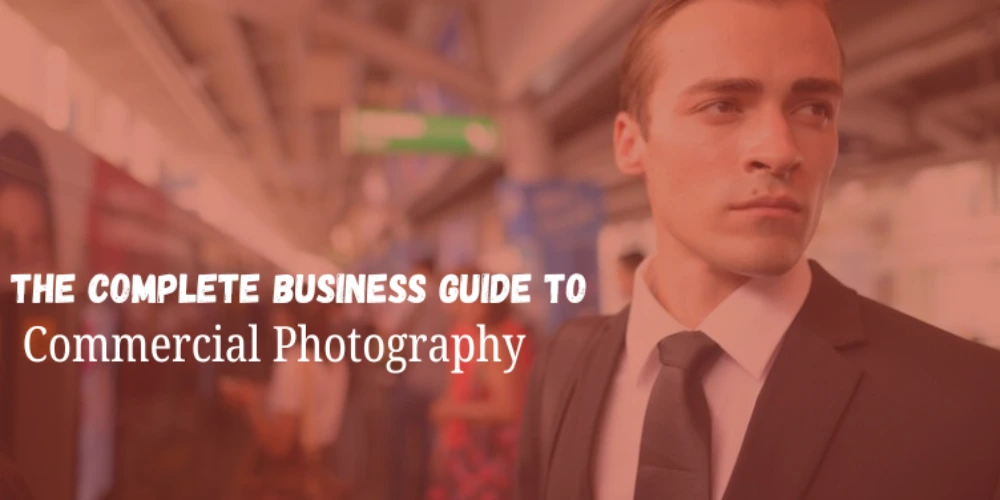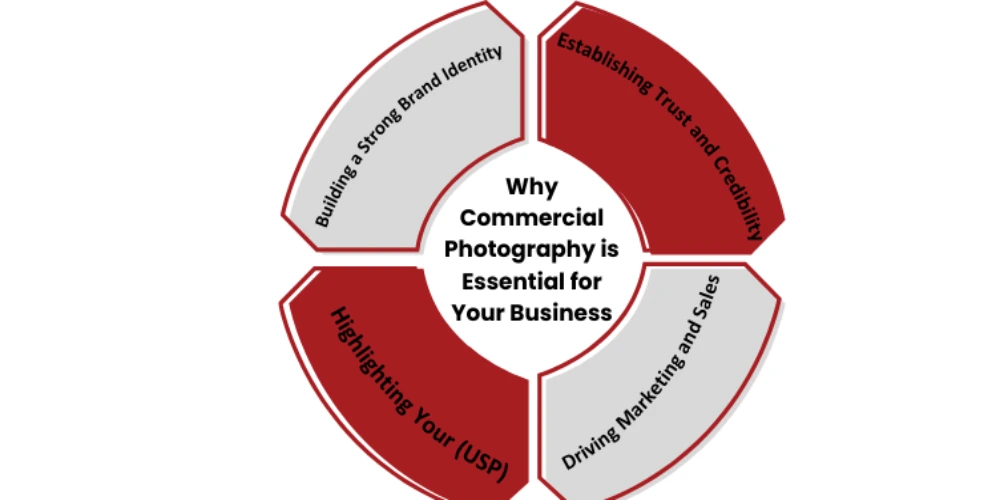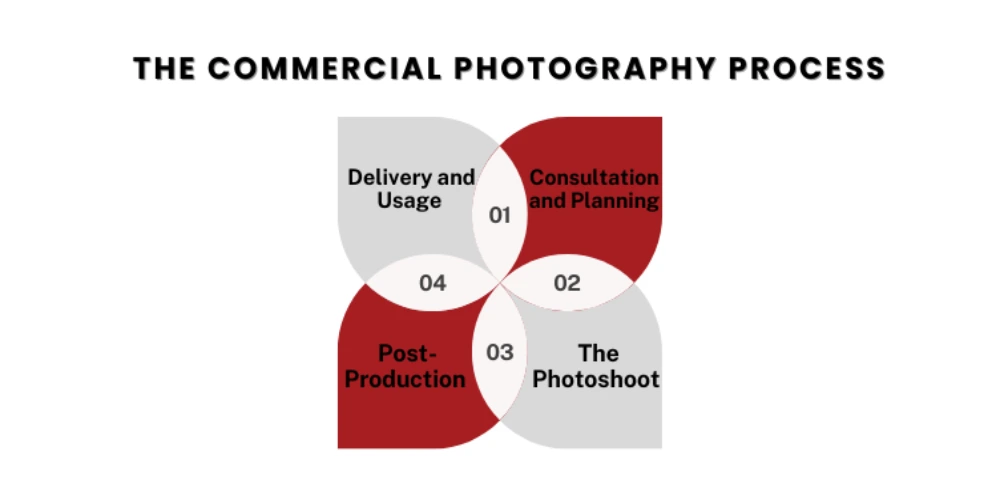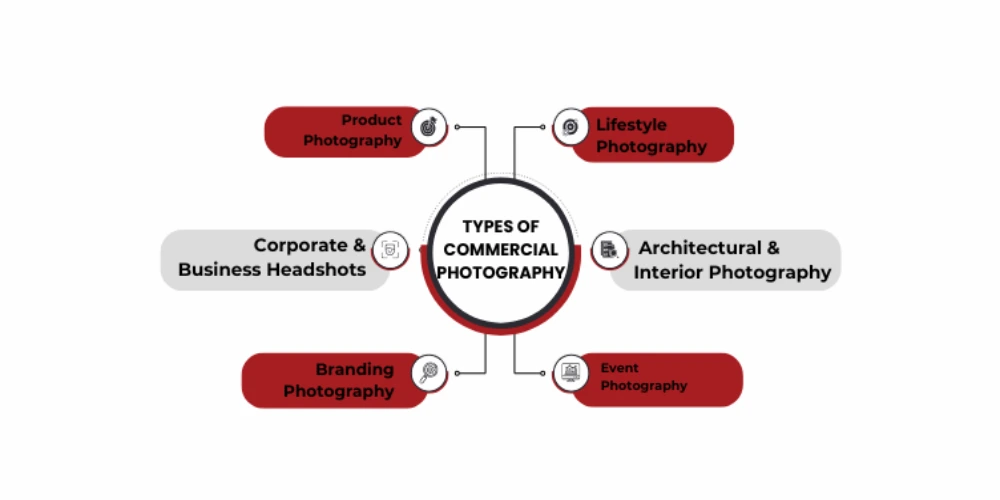The Complete Business Guide to Commercial Photography
How does your business differentiate itself and engage customers in today’s competitive market? Your brand is often seen before your products or services are experienced.
Whether it’s a product image, a team portrait, or an ad visual, the first impression plays a critical role in shaping customer perceptions. In the digital age, this visual impact is more important than ever.
Commercial photography isn’t just about capturing attractive images—it’s about telling your brand’s story. Professional photography enhances credibility, clarity, and authority, building a positive connection with your audience.
This guide will explain commercial photography, why it matters, the types you can choose from, and how to use it to achieve your business goals.

What Is Commercial Photography?
Commercial photography refers to professional images created specifically for business purposes, aimed at promoting products, services, or brand identity. These photos are utilized in advertising, marketing, websites, social media, and print materials. Unlike editorial or fine art photography, commercial images are designed to achieve specific business goals, such as increasing sales, enhancing brand perception, or engaging customers.
According to industry research, professional commercial photography enhances trust and conversion rates by up to 40%, making it a key tool for any business looking to stand out and build a strong visual presence.
Key Characteristics of Commercial Photography
- Strategic Purpose: Each photo is planned to serve a specific business goal—like boosting sales, increasing engagement, or telling your brand story.
- Audience-Focused: The images are crafted to speak directly to your ideal customers and what they care about.
- Professional Quality: Lighting, composition, editing, and technical skill all work together to make your business look polished and credible.
- Multi-Platform Use: These images are designed to perform well across websites, social media, ads, brochures, packaging, and more.
Why Commercial Photography is Essential for Your Business
It’s not just about looking good—it’s about showing who you really are, and here is how commercial photography can bring that to life for your business

1. Building a Strong Brand Identity
A strong brand identity starts with consistency. A custom commercial photography plays a key role in presenting your business in a way that is professional, recognizable, and aligned with your values. The right photos can convey the essence of your brand, from its personality to its core values, in a way that words alone cannot.
- Visual Consistency and Professionalism: High-quality images help ensure that your brand looks polished and professional across all channels.
- Conveying Brand Personality and Values: Your photos should reflect your company’s unique character, whether you’re fun and friendly, sophisticated, or adventurous.
- Differentiation in a Competitive Market: In a crowded marketplace, distinct and thoughtful photography can make your business stand out from the competition.
2. Establishing Trust and Credibility
Authentic visuals play a crucial role in establishing custom commercial photography trust. When customers see real photos of your products, services, and team, they are more likely to feel connected and confident in your brand.
- Authenticity Matters: Real photos, rather than stock images, help customers feel that they are engaging with a genuine business.
- Avoiding Generic Stock Photos: Stock photos can feel impersonal and unreliable, while custom photography shows the true face of your company.
- Demonstrating Professionalism and Attention to Detail: High-quality, thoughtful images signal that your business is serious and trustworthy.
3. Driving Marketing and Sales
Effective commercial photography can be a driving force in your marketing efforts, influencing engagement and conversion rates across various platforms.
- Increasing Engagement on Social Media and Websites: Visually appealing images boost engagement on platforms like Instagram, Facebook, and your business website.
- Improving Conversion Rates: High-quality photos help customers visualize themselves with your product, improving the likelihood of them making a purchase.
- Creating Compelling Advertising Campaigns: Powerful images grab attention and create emotional connections, making your ads more effective.
- Showcasing Products and Services Effectively: Clear, professional product shots make it easier for customers to understand what you’re offering.
4. Highlighting Your Unique Selling Proposition (USP)
The right photos can communicate exactly what makes your business special.
- Visually Communicating Your USP: Professional images can highlight what sets you apart from competitors, whether it’s your product quality, customer service, or innovation.
- Capturing the Essence of Your Offering: Through the power of custom commercial photography, you can showcase what makes your business truly unique in a way that resonates with your audience.
Types of Commercial Photography
1. Product Photography
Product photography is essential for showing your products in the best light, whether for your website, online store, or marketing materials. There are two main styles:
- Studio Shots (Clean Backgrounds): These are simple, professional images where the product is placed against a neutral background. It helps the product stand out and appear clean and crisp.
- Lifestyle Shots (Product in Use): These images show your product in real-world settings, helping customers visualize how it fits into their lives.
- E-commerce and Catalog Photography: High-quality product images specifically created for online stores and catalogs, ensuring your products look appealing and easy to shop.
2. Corporate & Business Headshots
Commercial Headshots are more than just photos—they help humanize your business and build trust.
- Professional Portraits for Teams and Individuals: High-quality headshots show your team as approachable and trustworthy, making a strong first impression.
- Consistency Across Organizations: Having consistent headshots across your business helps create a unified, professional look.
- Building Personal Connections: A great headshot can make your team more relatable and approachable, strengthening connections with clients and partners.
3. Branding Photography
Branding photography captures the essence of your business and tells your story.
- Capturing the Story and Atmosphere of Your Business: These images help convey your company’s mission, vision, and values.
- Photos of Your Space, Team Working, and Culture: They highlight what makes your business unique—whether it’s your work environment, your team’s energy, or your culture.
- Used for Website, Social Media, and Marketing Materials: These images help build a strong brand identity across your marketing platforms.
4. Lifestyle Photography
Lifestyle photography shows your products or services in a real-world context.
- Showing Your Product or Service in a Real-World Context: These images help customers connect emotionally by seeing how your product fits into their lives.
- Evoking Emotion and Connection: The goal is to create an emotional connection with potential customers by showing your product in action.
5. Architectural & Interior Photography
This type of photography is perfect for showcasing business locations, offices, or retail spaces.
- Showcasing Business Locations, Offices, and Retail Spaces: Whether you want to highlight your store, office, or commercial space, these photos give a professional view of your physical space, helping clients feel more familiar with your business.
6. Event Photography
Event photography captures your corporate events, conferences, product launches, and other business gatherings.
- Capturing Corporate Events, Conferences, and Launches: These images show the scale and professionalism of your events, making them great for marketing and social media content.
The Commercial Photography Process
To get the best results from your photoshoot, a clear, step-by-step process ensures every image supports your business goals and brand message.

Step 1: Consultation and Planning
The first step in the process is to plan everything carefully to ensure the photoshoot aligns with your business goals.
- Defining Goals, Target Audience, and Visual Style: Start by discussing what you want to achieve with the photos. Who is your target audience, and what style will best communicate your brand?
- Developing a Shot List and Creative Brief: Together with the photographer, you’ll create a detailed list of the shots you need, and a creative brief to guide the photoshoot.
- Location Scouting and Logistics: If the shoot takes place outside the studio, you’ll decide on locations, ensuring they fit the look and feel you want.
- Budget and Timeline Discussion: It’s important to set a realistic budget and timeline for the project to ensure smooth execution.
Step 2: The Photoshoot
The photoshoot is where all the planning comes to life. During this phase, you’ll focus on capturing your vision.
- Preparation (Talent, Props, Location): Ensure all the necessary elements—talent (models, staff), props, and locations—are ready and set up.
- Working with the Photographer and Team: Collaborate with the photographer and team to ensure everything goes according to plan. Clear communication is key to getting the perfect shots.
- Ensuring All Planned Shots Are Captured: Make sure the photographer captures all the essential shots outlined in the creative brief.
Step 3: Post-Production
Once the photos are taken, the next step is refining them to make sure they look their best.
- Image Selection (Client Review Process): The photographer will provide you with a selection of the best images. You’ll review these and provide feedback on the final picks.
- Editing and Retouching: This involves editing the images to enhance colors, remove distractions, or adjust lighting, ensuring the photos are polished.
- Color Correction and Grading: Color correction ensures that the colors look natural and consistent across all images, while grading adds the right mood and atmosphere.
Step 4: Delivery and Usage
After everything is finalized, the last step is getting your images ready for use in marketing materials.
- Receiving Final Images in Required Formats: The photographer will deliver the final images in various formats based on your needs—whether for print, web, or social media.
- Understanding Licensing and Usage Rights: Make sure you understand how you can use the images (online, in print, etc.) and whether there are any restrictions.
- Integrating Photos into Marketing Materials: Use the final images across your website, social media, advertisements, and any other marketing materials to build your brand’s visual identity.
Choosing the Right Commercial Photographer
Selecting the right commercial photographer is crucial for ensuring your photos align with your business goals. Here are the key factors to consider when making your choice:
1. Assessing Portfolios
A photographer’s portfolio gives you a clear idea of their style, skill, and expertise. When reviewing portfolios, consider:
- Relevant Experience: Look for photographers who have experience in the type of photography you need, whether it’s product shots, corporate headshots, or branding imagery.
- Style: Ensure their photographic style matches the aesthetic you want for your brand. Check if their past work resonates with your vision.
2. Understanding Pricing Structures
Pricing can vary depending on the photographer’s experience, the type of shoot, and usage rights. Be clear on these aspects before committing.
- Day Rates vs. Per-Image Pricing: Some photographers charge a flat day rate, while others charge per image. Make sure you understand which pricing model applies to your project.
- Licensing Fees: Make sure to clarify any licensing fees that may apply if you plan to use the images for advertising or commercial purposes.
3. Checking Credentials and Reviews
A photographer’s reputation speaks volumes about their reliability and quality of work.
- Reputation: Look for a photographer with a strong track record in the industry. You can check online reviews or ask for references from past clients.
- Reliability: Ensure they are known for delivering on time and maintaining professional standards.
4. Communication and Chemistry
The photographer you choose should be easy to work with and understand your brand’s vision.
- Finding a Photographer Who Understands Your Vision: It’s essential to communicate your goals clearly. A photographer who listens and understands your ideas will be able to bring your vision to life more effectively.
- Chemistry: A good working relationship is key to getting the best results. Choose someone who feels like a good fit with your team and your style.
5. Contracts and Usage Rights
To avoid misunderstandings later, make sure everything is outlined in a contract before the shoot.
- Image Ownership and Use: Be clear on who owns the images after the shoot and how you can use them. Ensure that the contract covers licensing, distribution rights, and any potential exclusivity arrangements
6. E-E-A-T Consideration
When choosing a photographer, focus on their Experience, Expertise, Authority, and Trustworthiness (E-E-A-T):
- Experience: Look at their portfolio for evidence of professional experience in your industry.
- Expertise: Review testimonials and case studies to ensure their skill level matches your needs.
- Authority: Check if they have recognition in the industry, such as awards or collaborations with well-known brands.
- Trustworthiness: Read client reviews and ask for references to gauge their reliability and reputation.
Getting Ready for Your Commercial Photoshoot
Preparation is key to ensuring a smooth and successful commercial photoshoot. Here’s how to get ready:
1. Preparing Your Team
Your team’s appearance plays a significant role in how your business is portrayed.
- What to Wear: Ensure everyone knows the dress code and is dressed professionally and consistently. Avoid overly bright colors or patterns that may distract from the focus of the photos.
- Grooming: Make sure everyone is well-groomed. Hair, makeup, and personal hygiene should align with the professional image you want to convey.
- Roles: Clearly define who will be involved in the shoot and their roles (e.g., models, staff, or background talent). Make sure they know what’s expected of them.
2. Preparing Your Location
A clean and well-organized location makes a significant impact on the photos.
- Cleaning: Ensure the location is tidy and free from clutter. Pay attention to details like surfaces, floors, and windows to ensure they’re clean and presentable.
- Staging: Set up the space so it aligns with your brand’s image. Consider the lighting, props, and any elements that will be visible in the photos.
- Permissions: If you’re shooting in a rented or public space, make sure you have the necessary permissions and permits in place ahead of time.
3. Gathering Props and Products
Props and products should be prepared and organized for easy access during the shoot.
- Ensuring Everything is Ready: Double-check that all props, products, and materials are on hand and in good condition. This includes any signage, furniture, or items that will be featured in the shoot.
4. Creating a Shot List
A shot list is a roadmap for the photoshoot, ensuring no important shots are missed.
- A Clear Plan for the Day: Create a detailed shot list that includes all the images you need, in the order they should be taken. This will help the photographer stay on track and maximize the time.
5. Communicating with Your Photographer
Effective communication ensures the shoot runs smoothly and that your vision is realized.
Staying Aligned on Expectations: Before the shoot, discuss your goals with the photographer. Be clear about your expectations regarding the style, tone, and types of shots you want. Regular communication during the shoot will help address any adjustments or concerns as they arise.
Measuring the Success of Your Commercial Photography
Great photos are only valuable if they deliver results. Here’s how to track the impact of your commercial photography on your business:
1. Tracking Engagement
Measure how your audience responds to the visuals.
- Website Dwell Time: Check how long visitors stay on pages with commercial images. Longer time usually means the content is engaging.
- Social Media Likes/Shares: See how your audience reacts to images on platforms like Instagram, Facebook, or LinkedIn. More likes, comments, and shares signal strong visual appeal.
2. Monitoring Conversion Rates
Track whether your photos help move people to take action.
- Sales or Lead Generation: Compare conversion data before and after using professional images. High-quality photos often lead to better product interest, form submissions, or purchases.
3. Gathering Feedback
Feedback offers direct insights into how your visuals are received.
- Customer Reactions: Ask customers how they found your site or what they think of your visuals. Positive comments can validate your investment.
- Internal Team Input: Your sales or marketing teams can offer useful feedback on how the images support their efforts or help close deals.
4. Analyzing Usage Across Platforms
Not all platforms perform the same—see where your photos work best.
- Performance Review: Check which images perform best on different channels (website banners, ads, social posts). Use this data to guide future shoots and placements.
5. Calculating ROI (Return on Investment)
Measure the financial impact of your photography.
- Return vs. Cost: Weigh the results—like increased traffic, conversions, or sales—against the cost of the shoot. If revenue grows after using new visuals, the investment is paying off.
Did You Know? A small online store replaced low-quality supplier photos with custom product images. As a result, their conversion rate jumped by 30% in just a few weeks. |
Custom vs. Stock vs. DIY Photography
| Feature | Custom Commercial Photography | High-Quality Stock Photography | DIY Photography (Smartphone/Amateur) |
| Authenticity | Highly authentic; showcases your actual team, products, and environment, enhancing brand trust. | May appear generic; images are often used by multiple businesses, reducing uniqueness. | Varies greatly; may lack professionalism and consistency, potentially impacting brand perception. |
| Brand Alignment | Tailored precisely to your brand’s messaging, style, and objectives, ensuring cohesive visual identity. | Limited options; finding images that perfectly match your brand can be challenging. | Difficult to achieve consistency and professional alignment without expertise. |
| Usage Rights | Exclusive or clearly defined rights; negotiated based on usage scope and duration, providing flexibility and control. | Requires careful licensing; often non-exclusive and widely used, which may limit differentiation. | Full control if you own the equipment; however, quality limitations may restrict professional use. |
| Quality & Control | Highest quality with maximum control over the outcome; allows for specific adjustments to meet brand standards. | Quality can be high, but control over specifics is limited; customization is not possible. | Quality is highly variable; technical limitations and lack of expertise can result in subpar images. |
| Cost | Higher upfront investment; day rates range from $1,000 to $5,000+, with additional costs for licensing and post-production. | Varies; subscription models or per-image fees ranging from $0.25 to $500, depending on the agency and image quality. | Low upfront cost if equipment is owned; however, high cost in time and potential need for additional tools or training. |
| Differentiation | Significant differentiator; provides unique visual assets that set your brand apart in a competitive market. | Minimal differentiation; commonly used images may not effectively distinguish your brand. | Can make the brand appear small or amateur if not executed professionally. |
| Time Investment | Requires planning and a dedicated shoot day; however, results in long-term assets that can be reused across campaigns. | Quick access; minimal time investment in searching and licensing images. | Significant time investment in shooting, editing, and planning, which may detract from other business activities. |
| Memorability | Highly memorable; custom visuals resonate more with audiences and reinforce brand identity. | Low; stock images are often overlooked and fail to leave a lasting impression. | Low; unless executed exceptionally well, DIY images are unlikely to be memorable. |
| Ideal Use Case | Core branding, key products, team photos, unique spaces, and major marketing campaigns where brand image is paramount. | Supporting visuals, blog posts, or when custom photography isn’t feasible; suitable for filler content. | Internal use, quick social media posts, or non-critical applications where professional quality is not essential. |
Frequently Asked Questions
How much does commercial photography cost?
The cost of commercial photography varies depending on several factors — such as the photographer’s experience, the size and length of the shoot, the number of final images, locations, and the type of usage rights you need. Expect to pay anywhere from $500 to $5,000+ per project. The best approach is to request a custom quote that matches your specific needs and goals.
What are image usage rights?
Usage rights explain how, where, and for how long you can use the photos. Most commercial photographers keep the copyright and grant you a license to use the images for agreed purposes — like on your website, in ads, or across social media. Always confirm usage terms before your shoot to avoid legal or licensing issues later.
How is commercial photography different from portrait photography?
Commercial photography is created to promote a business — it includes product shots, branding images, headshots, and more. Portrait photography is typically for personal use and focuses on individuals or families. While business headshots fall under both categories, commercial photography is always tied to a business goal like marketing, branding, or selling.
Can I just use my smartphone for business photos?
Smartphones are handy for casual use, but they usually fall short for professional business needs. They lack advanced lighting control, resolution, and consistency. If you want to build trust, stand out, and create strong first impressions, professional commercial photography is the better investment — especially for websites, ads, or print materials.
How long does a commercial photoshoot take?
It depends on the complexity of the shoot. A simple headshot session may take 30 to 60 minutes. A larger project like a branding or product shoot could take a full day or more, especially if multiple locations, setups, or people are involved. A good photographer will define the timeline during the planning phase.
Bring Your Brand to Life with DNB Productions
Every business has a unique story to tell, and how you present that story visually can shape how people perceive and trust your brand. Throughout this guide, we’ve shown that commercial photography is much more than just attractive images. It helps build credibility, express your values, and set you apart in a competitive market. At DNB Productions, we specialize in creating visuals that speak directly to your audience. Whether you’re launching a new product, refreshing your website, or strengthening your brand presence, we’re here to ensure your photos reflect the quality of your business. If your current visuals aren’t capturing what makes your business stand out, it’s time for a change.
Your business deserves to be seen in its best light. Let us help you make that happen!.
DNB Productions
Douglas N. Burns
we specialize in bringing your business to life through exceptional commercial and business photography.

